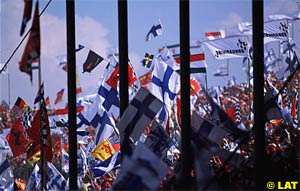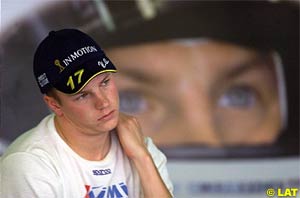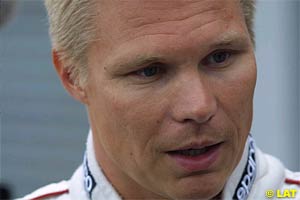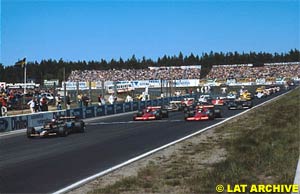
Atlas F1 Senior Writer
Finland had become a regular source of Formula One excellence, with two F1 World Champions and a rapidly rising rookie star. And yet, there doesn't seem to be a Finnish Grand Prix on the horizons of the F1 World Championship calendar. Thomas O'Keefe set out to investigate whether this could change any time soon
What more does a country have to do to prove itself worthy of a Grand Prix?
According to president of the FIA Max Mosley, it is not Finland's fault that it does not have a Formula One race, but it is also probably not on the cards anytime soon. Interviewed on the subject, Mosley pointed out that Finland's eligibility to become a Formula One venue suffers from its location as a European country. "We already have a disproportionate number of races in Europe as compared to the rest of the world", Mosley told Atlas F1, referring to the 11 of the 17 races on the calendar that are now taking place in European countries.
Mosley also noted that other European circuits like Estoril (formerly the site of the Grand Prix of Portugal from 1984 to 1996 and the circuit where Ayrton Senna won his first race in 1985) have been knocking on the door to get back into Formula One, and would most likely get preference over an entirely new European venue like Finland. And when asked if any entity like Finnish telecommunications giant Nokia had ever contacted the FIA to express interest in funding a track or sponsoring a Finnish Grand Prix, Mosley said he was not aware of any such contacts. As a consequence, it is our duty to report that as wild as Finland is for Formula One, the Grand Prix of Helsinki or other such place remains "fairly low on the list of priorities," according to Mosley.
As Mosley also noted, one of the essential requirements that Finland currently lacks is a world class Formula One track. The history of the most recent "new" Formula One circuits is instructive on that score. Malaysia, which is the second newest venue in Formula One, having had its first Grand Prix of Malaysia in 1999, faced the same situation as Finland and ended up building from scratch a magnificent facility in Sepang, located about 8 miles from the Kuala Lumpur airport.
The Prime Minister of the Government of Malaysia was fully behind the project. In addition, Petronas, the state-owned oil company of Malaysia, is the main sponsor of the Sauber Formula One team and even the Sauber's Ferrari-based engine is labelled Petronas. In sum, the Malaysia race came together because the country was already heavily involved through Petronas in Formula One, the Malaysian Government fully backed the circuit, and it was in a non-European setting, thus promoting Formula One's image as the "World" Championship. Malaysian Alex Yoong's appearance on the scene as a Minardi driver towards the end of the 2001 season is more evidence of how deeply the country is committed to making it in Formula One.
Most recently, Bernie Ecclestone and Tom Walkinshaw, owner of the Arrows team, announced in May 2001, that Russia is in the running as a future Grand Prix site, with plans for a $100 million 2.24 mile state-of-the-art race track to be built on Nagatino Island, a location overlooking the Moskva River, a few kilometers south of Moscow, a race tentatively pencilled in for 2003. Says Ecclestone: "Moscow has changed a great deal since the last time I was there eight years ago. We have eight venues seeking Formula One rights at the moment, but I believe this is where the next event should be."
Indianapolis, the latest venue to be anointed by the FIA to stage a Formula One race, reflects another approach to becoming a Grand Prix venue. Unlike Finland, where no obvious "Hakkinenring" exists to build upon, there was always a prime track in the running in the United States among the several possibilities. But it took Tony George, the President of the Indianapolis Motor Speedway, almost ten years to convince Formula One to return to America, a country of 260 million, because of the mixed experience Formula One had had with prior venues in the States.
Prior to the Inaugural US Grand Prix at Indianapolis in September 2000 (which sold out at 220,000 tickets, a higher attendance figure than any other Formula One venue by far), Formula One's prior United States Grand Prix foray at Phoenix in 1989-91 was a disaster, with appallingly low attendance (35,000 in 1991), and run on a circuit cobbled together from the streets of downtown Phoenix, featuring concrete barriers, chain link fences and manhole covers, not the kind of terrain features associated with European road circuits. On the other hand, memorable Grands Prix had been held over the years at bucolic Watkins Glen in Upstate New York and on the streets of Long Beach, California, so America was a mixed story from the standpoint of Formula One.
When Ecclestone was asked why Indianapolis was chosen as the permanent home for the US Grand Prix over other potential venues Formula One racing fans might more instinctively favor - such as Watkins Glen, Elkhart Lake, Laguna Seca, Long Beach or Las Vegas - his answer was blunt and brutally commercial: "Indy is Indy. When you go anywhere in the world, and you talk about Indianapolis, it is like talking about Coca-Cola or Rolls-Royce: everybody knows it ... and we need to have that kind of place that our people [i.e. the sponsors] can bring their guests to." So much for picturesque road circuits set amongst trees in obscure parts of Wisconsin and Upstate New York.
But what about Las Vegas, then? Surely it is an entertainment Mecca that sponsors would be happy to bring their guests to. You will be surprised to learn that Ecclestone "was disappointed that we didn't get the job done there" and was very interested in running Formula One cars in Las Vegas and not, mind you, through pylons on a makeshift track in the parking lot of Caesar's Palace. "What I had in mind is [the race] running by the Bellagio [Hotel]." Ecclestone's idea was to Go Big and Flaunt It but the casinos apparently would not go along: Ecclestone's Formula One circuit would have incorporated the actual Las Vegas Strip running past the major hotels as the main straightaway, a Mulsanne straight in the desert!
With the Malaysia and Indianapolis precedents as guidelines, what route would Finland have to take to gain a seat at the Formula One table? To begin with, of course, a racetrack would have to be found or built in a place hospitable enough for the clientele Ecclestone is talking about - all those sponsors and their guests who are allowed access by electronic gate passes into the exclusive Paddock Club on Grand Prix weekends.
Interestingly, if there ever were to be a Grand Prix developed for Helsinki, it would not be the first time this happened, since Helsinki hosted Finnish Grands Prix going back to the mid-1930s. For example, on May 12th 1935, a Formula Libre (anything goes as to engine specifications) race was held in downtown Helsinki at Elaintarharata, with Finn Karl Alfred Ebb's privateer Mercedes Benz SSK taking the victory. The Helsinki track was uniquely situated in that the main straight ran parallel to a tall earthen banking on top of which ran a railroad line. On race day, a special train brought spectators from the railroad station to the spot where the railroad banking overlooked the track and where the train was stopped during the race, acting as a Grandstand: the first Paddock Club.
Earlier that year, in February 1935, the Norges GP was held on a frozen lake 10 kilometers from Oslo, with Swedes and Finns dominating the race over the non-Scandinavians. Races like this went on throughout the 1930s until the war came and on several occasions at Helsinki. One wonders whatever possessed these drivers to race Grand Prix cars on ice lakes, but there is certainly no doubting the depth of feeling for Grand Prix racing that is embedded in the Scandinavian character.
With that rich national racing history, are there any race tracks that already exist in Finland that could be built upon, as Indianapolis did, to attract Formula One? Helsinki had an old street circuit, now defunct, and later on a mid-1990s temporary street circuit for touring cars running around the waterfront and through downtown. But a circuit like that may be too reminiscent of the downtown Phoenix experience to be appealing to the organizers of Formula One. The 0.91 mile Artukairen circuit near Turku is also obviously not a candidate for Formula One.
There are, however, a few tracks in Finland - like the dramatic Ahvenisto circuit in Hameenlinna, where races in the lower formulas that are the stepping stones to Formula One currently are held - that could conceivably be brought up to Formula One standard. Typically, an existing circuit plumping to host a Formula One race will proceed incrementally, first getting the track sufficiently up to speed as to safety standards to be licensed as a Formula One testing track, and then subsequently investing the millions upon millions in corporate suites and outfitting the garage, paddock area and other facilities required to accommodate the FIA's safety and sporting regulations and the needs of the all-important sponsors of the Formula One teams and their clientele Ecclestone is so conscious of. This is the pattern being followed by some of the other tracks out there lining up for a Formula One race: Kyalami in South Africa, Zandvoort in Holland, and Estoril in Portugal.
Is anyone out there with Finnish capital willing to take the plunge? If so, we have a number for you to call of a bespectacled man in London who might be interested. For although Mosley has spoken on the subject, it should be remembered that Ecclestone and Mosley do not always agree on everything; indeed, it was Ecclestone, after all, who - in the mid-1980s, when the Cold War was still on - initiated the novel idea for the Grand Prix of Hungary on a track located 13 miles outside of Budapest (which the Finns go to in droves every summer).
To be sure, when it comes to Grand Prix venues, many are called but few are chosen. Over the years, Ecclestone has been reportedly in discussions with venues as disparate as Lebanon, Bali, Egypt, Greece and Croatia (Ecclestone's wife, Slavica, is from Croatia) as possible sites for a Formula One race. In early 2000, it was revealed that negotiations for a Grand Prix of Korea had fallen through when the developer defaulted, so not all of these press releases will ultimately produce racetracks. Notwithstanding Mosley's reservations then, would Finland be so out of place in a motley group of candidate venues such as this, now even including its neighbour Russia?
In commenting on the Finnish character in the early stages of World War II, another famous Englishman, Prime Minister Winston Churchill, had this to say as to the resistance of the Finns to its Russian neighbour's attempts at domination: "The service rendered by Finland to mankind is magnificent. They have exposed for all the world to see the military incapacity of the Red Army and of the Red Air Force. Many illusions about Soviet Russia have been dispelled in these few fierce weeks of fighting in the Arctic Circle. [Finland has been] Superb, nay, Sublime ... Finland shows what free men can do." With this Churchillian spirit imbued in the national character, can Ecclestone and Mosley be that much more difficult to overcome than the Russians?
Assuming a Grand Prix of Finland was ever approved, it is interesting to reflect on the kind of racing seen in Scandinavia the last time Formula One went North. The Swedish Grand Prix, which was run from 1973 through 1978, has a short but colorful track record that would bode well for a Grand Prix of Finland. The Swedish Grand Prix came into being the same year as did the Brazilian Grand Prix that is still on the calendar - 1973 - an unusual year when two new Grands Prix were added to the calendar. Ironically, although Jackie Stewart in his Tyrrell-Ford went on to win his third and last World Championship in 1973, his two closest rivals were from the countries with the new Grands Prix that year: Ronnie Peterson of Sweden and Emerson Fittipaldi of Brazil, both with Lotus-Ford. As would be the case now with the notoriety of Mika Hakkinen, Mika Salo and Kimi Raikkonen, it seemed that the prominence of Ronnie Peterson at that time contributed to the impetus for a Swedish Grand Prix.
The first Swedish Grand Prix at the Anderstorp airfield circuit was held on June 17th 1973; the race is noteworthy because Denny Hulme's victory in a McLaren-Ford was the first victory for the McLaren M23, after domination of the season to that point by the Lotus and Tyrrell teams. Peterson had qualified on pole in his Lotus-Ford but could only manage to finish in second place in the race. Indeed, Peterson was never able to win his "home" Grand Prix.
In 1976, Scheckter and Depailler repeated their 1974 performance of finishing first and second in Tyrrell-Fords, but this time in an even more spectacular fashion: they did it in the unique six-wheeled Tyrrell P34 designed by Derek Gardner, the only time this unusual car ever won a race.
In 1977, Mario Andretti had qualified his Lotus 78 on pole, but he ran out of fuel two and a half laps before the finish and Jacques Lafitte took his V12 Matra-powered JS7 Ligier to victory, the only time this famously loud and beautifully turned out engine scored a Championship win.
In 1978, yet another unique car won what was to be the Swedish Grand Prix - the flat-12 Alfa Romeo-engined Brabham BT46B, the so-called "Fan Car", designed by Gordon Murray with a fan attachment at the rear that was intended to increase downforce by sucking air like a vacuum cleaner from under the car. The fan device was so successful that it was banned as an illegal aerodynamic aid by the sporting body, thus leaving the last Swedish Grand Prix as the only race and the only victory for the "Fan Car".
What can be learned from this history of the Swedish Grand Prix as it may bear upon a potential Grand Prix of Finland? To begin with, given the weather considerations, all the Swedish Grands Prix were held in mid-June, currently the date occupied by the Canadian Grand Prix; the Finnish Grands Prix in Helsinki were typically held in May. Since there are already 17 races, locking a date in May or June for Finland may be more difficult now than it was back in the 1970s. But weather per se should not be a consideration as the Swedish races have shown.
Secondly, for some obscure reason, the Swedish Grand Prix smiled favorably upon cars looking for their debut win, particularly oddball one-off cars: the Brabham BT46B "Fan Car", the Tyrrell P34, the McLaren M23 and the V12 Matra-engined Ligier. Because a Finnish race would also likely be in June, it would by definition be mid-season when all the teams are pressing their advantage as they did in the days of the Swedish Grand Prix and thus likely to continue the Scandinavian tradition of producing competitive racing.
Third, Finns can be counted on to turn out in great numbers to support a Formula One track. In the Helsinki races of the 1930s, 40,000 people or more routinely showed up for the Finnish Grands Prix. The inaugural Grand Prix of Hungary in 1986 (which Finns today consider their "home" Grand Prix) attracted 200,000. And even in the late 1970s, the 1978 Swedish Grand Prix - its last year - attracted 45,000 people, which compared favorably with attendance at other European tracks during that era, such as Spain (35,000), Belgium (49,000), France (55,000) and Holland (65,000).
Fourth, and most importantly, with all the amenities modern Finland has to offer the Formula One fan, including the health spas, resorts, museums, the forests, the cities, the castles, the cathedrals, the global transportation and communications network and its enthusiasm for motorsports, Ecclestone can be assured that if Finland did become a Grand Prix venue, it would in all probability turn out to be a place that "our people", as Bernie likes to call them, would enjoy returning to year after year as they do now to Monaco, Monza and Spa.
It is a country of 5.2 million people, 1.5 million saunas, 2 Formula One World Champions and no Formula One race. How likely is it that this last fact will ever change, now that Mika Hakkinen has done his manager Keke Rosberg one better and become World Champion twice, now that Mika Salo has been honoured by becoming Toyota's No. 1 driver for 2002, and now that Tommi Makinen and Marcus Gronholm have year after year heaped glory upon glory on Finland as World Rally Champions?
 It should also be noted that the McLaren-Mercedes team have also done their best to project Finland as a site for a Formula One venue: who can forget the video in the off-season of Mika and the then-pregnant Erja Hakkinen running the McLaren Two-Seater Formula One car in the snow at a location listed as "Somewhere in Finland". And, most recently, yet another Finnish star has emerged in Kimi Raikkonen, 22 years old, who has made a meteoric rise from British Formula Renault to the Sauber Team, to taking Hakkinen's place at McLaren, all in less than two years' time; hoping to become the youngest World Drivers' Champion ever.
It should also be noted that the McLaren-Mercedes team have also done their best to project Finland as a site for a Formula One venue: who can forget the video in the off-season of Mika and the then-pregnant Erja Hakkinen running the McLaren Two-Seater Formula One car in the snow at a location listed as "Somewhere in Finland". And, most recently, yet another Finnish star has emerged in Kimi Raikkonen, 22 years old, who has made a meteoric rise from British Formula Renault to the Sauber Team, to taking Hakkinen's place at McLaren, all in less than two years' time; hoping to become the youngest World Drivers' Champion ever.
 Also in Asia, it should be noted that there is a circuit called Zhuhai in China that is located a helicopter ride (or a 75 minute ferry ride) from Hong Kong that seems to be following the Malaysian model in developing a state-sponsored Grand Prix venue, but to date without the success Malaysia has enjoyed.
Also in Asia, it should be noted that there is a circuit called Zhuhai in China that is located a helicopter ride (or a 75 minute ferry ride) from Hong Kong that seems to be following the Malaysian model in developing a state-sponsored Grand Prix venue, but to date without the success Malaysia has enjoyed.
 And speaking of deserts, among the most persistent rumors out of Formula One circles are proposals for a Grand Prix in the Middle East. In mid-January 2001, Ecclestone met with the Prime Minister of Lebanon, Rafik Hariri, to discuss the topic. Is there going to be a Grand Prix in Beirut? Not yet, and maybe not Beirut since Egypt and the United Arab Emirates are also in the region. Says Ecclestone: "There are quite a few countries we want to be in. There is a good chance of a Grand Prix in the Middle East. It is nice - a new place for sponsors to come from, and nice for people to go to. New markets are opening up."
And speaking of deserts, among the most persistent rumors out of Formula One circles are proposals for a Grand Prix in the Middle East. In mid-January 2001, Ecclestone met with the Prime Minister of Lebanon, Rafik Hariri, to discuss the topic. Is there going to be a Grand Prix in Beirut? Not yet, and maybe not Beirut since Egypt and the United Arab Emirates are also in the region. Says Ecclestone: "There are quite a few countries we want to be in. There is a good chance of a Grand Prix in the Middle East. It is nice - a new place for sponsors to come from, and nice for people to go to. New markets are opening up."
 So for a Finnish consortium to attract a Formula One race, the question remains: where will the Government or private resources be committed so that an existing circuit in Finland can be upgraded (or where is the available land and capital to develop a new circuit) that meets the complex and sometimes conflicting requirements of Ecclestone (a circuit located where Formula One sponsors will want to take their guests), of the FIA (a circuit that meets Formula One's exacting and expensive safety specifications) and of the fans (a track where there will be good wheel-to-wheel racing rather than just passing in the pits due to pit strategy as is often the case in modern Formula One).
So for a Finnish consortium to attract a Formula One race, the question remains: where will the Government or private resources be committed so that an existing circuit in Finland can be upgraded (or where is the available land and capital to develop a new circuit) that meets the complex and sometimes conflicting requirements of Ecclestone (a circuit located where Formula One sponsors will want to take their guests), of the FIA (a circuit that meets Formula One's exacting and expensive safety specifications) and of the fans (a track where there will be good wheel-to-wheel racing rather than just passing in the pits due to pit strategy as is often the case in modern Formula One).
 In 1974, the Swedish Grand Prix produced a surprising win for the Tyrrell-Fords, which finished in first (Jody Scheckter) and second place (Patrick Depailler). In 1975, Niki Lauda won in the Ferrari 312T, one of his five victories that year that led to the 1975 World Championship. Although Lauda won, the sensation of this race was Vittorio Brambilla, who qualified his bright orange March 751 and led for 16 laps before succumbing to tire problems and a broken half-shaft.
In 1974, the Swedish Grand Prix produced a surprising win for the Tyrrell-Fords, which finished in first (Jody Scheckter) and second place (Patrick Depailler). In 1975, Niki Lauda won in the Ferrari 312T, one of his five victories that year that led to the 1975 World Championship. Although Lauda won, the sensation of this race was Vittorio Brambilla, who qualified his bright orange March 751 and led for 16 laps before succumbing to tire problems and a broken half-shaft.
Acknowledgments: The author wishes to express his appreciation to Par Landor, editor of The Turkulainen newspaper in Turku, Finland, for suggesting this article, and also to credit Leif Snellman, whose fabulous Golden Era of Grand Prix Racing website, was relied upon for background on the Finnish Grands Prix of the 1930s.
Please Contact Us for permission to republish this or any other material from Atlas F1.
|
Volume 7, Issue 47
Articles
The Piranha Club Continues
Why No Finnish Line in Formula One?
Kicking the Crap Out of Formula One
Columns
Bookworm Critique
The Weekly Grapevine
> Homepage |